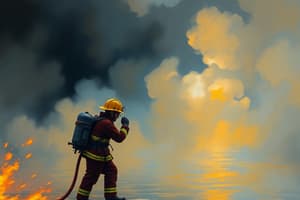Podcast
Questions and Answers
What is the primary consideration in assessing risks of the functional fire company?
What is the primary consideration in assessing risks of the functional fire company?
- The survival possibilities, probabilities, and certainties of the search (correct)
- The location of the building
- The number of firefighters available
- The size of the building
What should the decision-making process progress to when assessing risks?
What should the decision-making process progress to when assessing risks?
- Identifying risks to firefighters and fire victims, but not building construction or fire and smoke conditions
- Identifying only risks to firefighters
- Identifying only risks to fire victims
- Aggressively identifying all risks to firefighters and fire victims, personal and operational capabilities and limitations, building construction, fire and smoke conditions, flowpaths, and other assessible conditions (correct)
How in-depth can the process for determining an acceptable level of risk for a task be?
How in-depth can the process for determining an acceptable level of risk for a task be?
- It can be either in-depth or basic, depending on the person's choice (correct)
- It must be basic
- It is not necessary to determine an acceptable level of risk for a task
- It must be in-depth
When is it justifiable to take essential risks in the functional fire company?
When is it justifiable to take essential risks in the functional fire company?
What can survivability often depend on?
What can survivability often depend on?
What will result in the chances for civilian survival being relinquished?
What will result in the chances for civilian survival being relinquished?
What do fire service leaders need to understand about their actions?
What do fire service leaders need to understand about their actions?
What is necessary to close communication and perception gaps?
What is necessary to close communication and perception gaps?
What should be included in discussions about defining success and implementing a chosen culture?
What should be included in discussions about defining success and implementing a chosen culture?
What does being safe mean?
What does being safe mean?
Flashcards
Risk Assessment in Fire Companies
Risk Assessment in Fire Companies
Assessing risks in a fire company includes considering incident problems and potential dangers.
Fireground Decision-Making
Fireground Decision-Making
Decision-making in fire situations should prioritize identifying all risks to firefighters and victims, as well as the capabilities and limitations of resources.
Acceptable Risk Level
Acceptable Risk Level
The level of risk accepted for a task can be determined based on the situation and the potential for success while minimizing dangers.
Justifiable Risk Taking
Justifiable Risk Taking
Signup and view all the flashcards
Impact of Indecision
Impact of Indecision
Signup and view all the flashcards
Leader Influence on Safety
Leader Influence on Safety
Signup and view all the flashcards
Communication and Perception Gaps
Communication and Perception Gaps
Signup and view all the flashcards
Building Trust and Culture
Building Trust and Culture
Signup and view all the flashcards
Clear Safety Policies
Clear Safety Policies
Signup and view all the flashcards
Firefighter Safety and Occupational Hazards
Firefighter Safety and Occupational Hazards
Signup and view all the flashcards
Study Notes
- Experience in identifying incident problems and risks is important for assessing risks in the functional fire company.
- Sizing-up search based on survival possibilities, probabilities, and certainties is a primary consideration in the risks of the functional fire company versus the risk management model.
- The decision-making process should progress to aggressively identifying all risks to firefighters and fire victims, personal and operational capabilities and limitations, building construction, fire and smoke conditions, flowpaths, and other assessible conditions.
- The process for determining an acceptable level of risk for a task can be as in-depth or as basic as you choose for it to be.
- Splitting the truck company to address search and ventilation, initiating a fire attack using tank water, searching ahead for water cans, charging the line with the protection of isolating rooms on the opposite side of the fire from the fire attack group, and searching these rooms are essential and justifiable risks if there is any possibility of saving a life in these small occupancies.
- Survivability will often depend on whether or not the fire is compartmentalized, which is often difficult to determine from the street or even after performing a 360-degree size-up.
- Indecision or slow, poorly executed tactics or tasks will result in the window closing and the chances for civilian survival being relinquished.
- Fire service leaders need to understand the influence that their actions have on philosophy and mindset.
- It is important that chiefs understand that communication and perception gaps exist and that aggressive action is necessary to close the gaps.
- Two-way trust, a clear operational philosophy, and how professionals should balance safety and duty must be included in discussions about defining success and implementing a chosen culture.
- The definition of safety has been vague in the past.
- Safety practices can be seen as unrealistic or lack proper training.
- Safety policies should be specific and have a defined method for implementation and enforcement.
- Being safe means managing risks and recognizing hazards.
- Firefighter safety should not compete with victim survivability.
- The fire service is expected to reduce risk and provide rescue and control of fires.
- Concussions in football are equivalent to cancer in the fire service.
- The challenge is to protect firefighters while allowing them to perform at a professional level.
- The fire service is committed to addressing cancer concerns and providing safety measures.
- New firefighter job applicants are warned of the risks associated with the job.
Studying That Suits You
Use AI to generate personalized quizzes and flashcards to suit your learning preferences.



